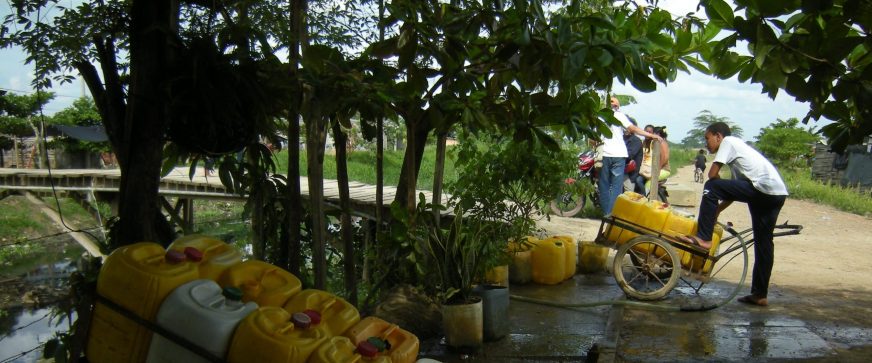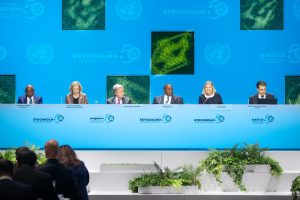- SIWI – Leading expert in water governance
- /
- Latest
- /
- How is the WASH sector responding to COVID-19? The case of Latin America and the Caribbean
How is the WASH sector responding to COVID-19? The case of Latin America and the Caribbean
 An informal waterpoint in Colombia.
An informal waterpoint in Colombia. Since the beginning of the outbreak, the Stockholm International Water Institute (SIWI) has mapped, in collaboration with UNICEF, some of the initiatives implemented by countries to i) ensure universal access to a minimum daily volume of drinking water and basic sanitation, ii) enhance safe hygiene behaviour and strengthen Infection Protection and Control, and iii) secure the continuity and affordability of WASH services and products. The mapping has been conducted intensively between end of March and June 2020. Initially, it included 15 countries but has been extended to cover up to 26 countries, including seven countries from the Caribbean.
On April 15, a brief concept note entitled “El sector del agua, el saneamiento y la higiene y su respuesta ante el COVID-19: Iniciativas en América Latina y el Caribe” was originally published in Spanish and then translated into French and English. It included measures and initiatives that countries adopted and implemented in their initial response. One first update was developed to cover new measures implemented until May 15th, 2020. A second update covered measures implemented between May 15 until June 15, 2020.
The way forward: Evolving from lockdown to de-escalation, recovery and working towards resilience
As the crisis evolves from lockdown to de-escalation (response phase) and eventually to recovery, both the context and sector priorities will shift accordingly. Beyond the lockdown and the back to a new normality, where typical measures have included confinement, physical isolation, and severe mobility restrictions, two additional phases can be defined: recovery and working towards resilience. Countries will need to consider specific response measures to address emerging needs and continue ensuring WASH services for all.
During the past months, the mapping of responses from countries has shown:
In Latin America:
- New measures have been identified to define areas of greater vulnerability (hot spots) to COVID-19 based on data from the water and sanitation sector.
- The role of access to WASH services is losing centrality in the messages, towards another approach of economic revival, once the confinement phase is over.
- Handwashing awareness campaigns are intensified, with 100% of countries taking specific measures to do so.
- Specific support measures for rural and community providers are beginning to be identified as support for response plans and management of funds for rural and community boards.
- Special funds are being dedicated both to guarantee the operation and to expand the water and sanitation infrastructure in several countries, such as Argentina, Mexico, Colombia, Peru, and Costa Rica.
- Specific economic difficulties are beginning to emerge on the part of service providers to pay their electricity bills and other operating costs (evidence in Mexico, Bolivia, Ecuador, Colombia, Brazil).
- Very little information disaggregated by gender is available, and especially with respect to access to water and sanitation, with the only exception in Brazil, where women who are mostly households heads in informal settlements or slums have discontinued access to water.
- There is new evidence of initiatives especially aimed at segments of the population that are in migration status. In some countries, community bathrooms and adapted spaces with sinks have been set up in migratory shelters, as well as mobile washing stations. (e.g. Mexico, Colombia).
In the Caribbean:
- Many countries have implemented measures prohibiting the disconnection of users and reconnecting previously disconnected users, as well as ensuring a minimum daily volume of drinking water for vulnerable and unconnected households through infrastructure expansion.
- There are many initiatives led by non-governmental organizations and private donors regarding the provision of hygiene kits for families at risk, including menstrual hygiene products.
- Some utilities are putting their own measures in place to protect workers such as providing face masks and equipment to its employees. There are sanitary protocols to safely provide water to the public and heightened safety protocols at work sites.
- The coverage and provision of water and sanitation services several countries have cited the COVID-19 crisis as catalyst for expansion of infrastructure; however, no measure has been found regarding the need to ensure electricity access for utilities to perform their operations and very little has been found with respect to ensuring the supply chains of materials needed for these operations.
- Few measures have been found regarding the implementation of specific sanitation measures.
- Countries which are reopening schools are ensuring handwashing stations are equipped with soap and water and that areas are disinfected before each new school day.
Initiatives to provide the technical and financial support that utilities need has shown to be weak, with only very few operators receiving funds to guarantee operation of services.

SIWI and UNICEF continue to work with governments and water utilities to support good practices. The mapping of responses will also continue, around the world – stay tuned for more updates.









